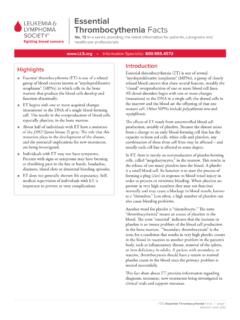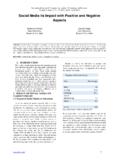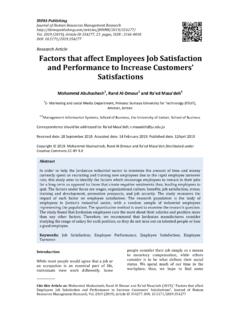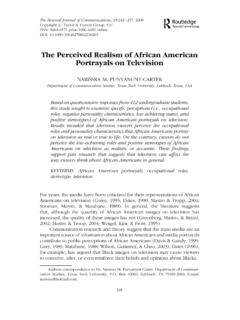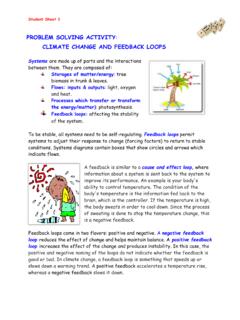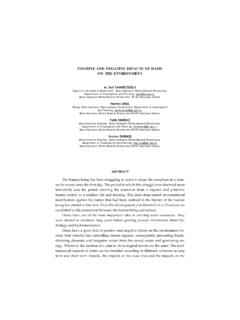Transcription of Minimal Residual Disease (MRD)
1 No. 35 in a series providing the latest information for patients, caregivers and healthcare professionalsSupport for this publication provided byMinimal Residual Disease (MRD) FACT SHEETH ighlights y Minimal Residual Disease (MRD) is a term used to describe the small number of cancer cells in the body after cancer treatment. An MRD positive test result means that Disease was still detected after treatment. An MRD negative result means that no Disease was detected after treatment. y Doctors use MRD to measure the effectiveness of treatment and to predict which patients are at risk of relapse. It can also help doctors confirm and monitor remissions, and possibly identify an early return of the cancer.
2 Y To test for MRD, doctors use samples from either a blood draw or a bone marrow aspiration. y For patients who are MRD positive , the number of remaining cancer cells may be so small that they cannot be detected through traditional tests, such as viewing cells under a microscope. y There are a few tests that can measure MRD. The more sensitive a test is, the more effective it is at finding a small amount of cancer cells among the many healthy cells. y The most widely used tests to measure MRD are flow cytometry, polymerase chain reaction (PCR) and next-generation sequencing (NGS).What Is Minimal Residual Disease (MRD)? Minimal Residual Disease (MRD) refers to the small number of cancer cells that remain in the body after treatment.
3 The number of remaining cells may be so small that they do not cause any physical signs or symptoms and often cannot even be detected through traditional methods, such as viewing cells under a microscope and/or by tracking abnormal serum proteins in the blood. An MRD positive test result means that Residual (remaining) Disease was detected. A negative result means that Residual Disease was not detected. The Role of Minimal Residual Disease (MRD) Assessment in Patient CareAfter treating cancer, any remaining cancer cells in the body can become active and start to multiply, causing a relapse of the Disease . Detecting MRD may indicate that the treatment was not completely effective or that the treatment was incomplete.
4 Minimal Residual Disease may be present after treatment because not all of the cancer cells responded to the therapy, or because the cancer cells became resistant to the medications used. When Being negative Means Something positive . When a patient tests positive for MRD, it means that there are still Residual cancer cells in the body after treatment. When MRD is detected, this is known as MRD positivity. When a patient tests negative , no Residual cancer cells were found. When no MRD is detected, this is known as MRD negativity. Being MRD negative is actually an encouraging outcome for a patient with blood cancer, because that means that even with sophisticated, sensitive tests, no cancer cells can be found.
5 Studies have shown that MRD negativity is associated with longer remissions and potentially longer rates of survival for certain blood cancers. 2 Minimal Residual Disease (MRD) How MRD Testing Can Affect Your Treatment. Testing for MRD can help the treatment team distinguish between patients who need additional (or different) treatment from those who do not. This knowledge can also potentially guide treatment decisions and improve patient Residual Disease testing can help: y Show how well the cancer has responded to treatment yConfirm and monitor remissions yFind cancer recurrence sooner than other tests y Identify patients who may be at a higher risk of relapse yIdentify patients who may need to restart treatment y Identify patients who may benefit from other treatments, such as stem cell transplantation or combination therapyWhen to Test for MRD.
6 There are different criteria for when to test for MRD, based on factors specific to the patient s Disease . Patients may be tested after the final cycle of a planned combination therapy, after bone marrow transplantation, during treatment to confirm the depth of remission, after one year on maintenance therapy, at regular intervals after treatment is completed, or at other specific times. Techniques to Detect MRD Minimal Residual Disease testing uses highly sensitive methods. The most widely used tests are flow cytometry, polymerase chain reaction (PCR) and next-generation sequencing (NGS). These tests use samples of bone marrow cells (taken by aspiration) and/or peripheral blood cells (taken through a vein).
7 Flow Cytometry. Flow cytometry is a technique that evaluates individual cells by checking for the presence or the absence of certain protein markers on the cell surface. A fresh bone marrow aspirate sample is required for reliable results. The bone marrow aspirate sample is treated with special antibodies that stick only to the cells that have a specific protein on them. Based on how the flow cytometry is set up, this approach can find one cancer cell among 100,000 bone marrow cells. Results can be available in less than one Chain Reaction (PCR). This technique expands trace amounts of DNA so that a specific segment of DNA can be studied. Polymerase chain reaction can identify malignant cells based on their characteristic genetic abnormalities, such as mutations or chromosomal changes.
8 Polymerase chain reaction essentially increases or amplifies small amounts of specific pieces of either DNA or RNA to make them easier to detect and count. As a result, genetic abnormalities can be detected by PCR even when a very small number of cancer cells remain. With PCR, it is possible to identify one cancer cell within 100,000 to one million normal cells. The test is done with a bone marrow or blood sample. It may take several weeks for results to be Sequencing (NGS). This technique refers to a number of different sequencing technologies. Next-generation sequencing tests can rapidly examine stretches of DNA or RNA. Next-generation sequencing can detect mutations and other genetic abnormalities in DNA extracted from a bone marrow aspirate sample.
9 This approach offers the potential for increased sensitivity it can detect one cancer cell in one million bone marrow cells checked. Test results are usually available within one week. Both fresh and frozen/stored samples can be used for NGS-based MRD testing. The US Food and Drug Administration (FDA) has approved a test called clonoSEQ, an NGS test designed to detect MRD in B-cell acute lymphoblastic leukemia (ALL) and more information about the techniques mentioned above, please see the free LLS publication Cancer Molecular Profiling. 3 Minimal Residual Disease (MRD) MRD Testing in Specific Blood CancersThe type of Minimal Residual Disease (MRD) testing used varies depending on the type of blood cancer.
10 Acute Lymphoblastic Leukemia (ALL) MRD is detected through flow cytometry, PCR and next-generation sequencing (NGS). MRD is part of routine testing in the treatment of pediatric and adult ALL. Studies show that MRD can predict the effectiveness of a given treatment after the induction phase of ALL treatment. MRD can help identify which patients are at higher risk for relapse, allowing for earlier or additional treatments. MRD may also determine which patients may benefit from a bone marrow transplantation. Chronic Lymphocytic Leukemia (CLL) MRD is detected by flow cytometry and PCR. Patients who remain MRD negative after the end of therapy for CLL may have better treatment outcomes.









